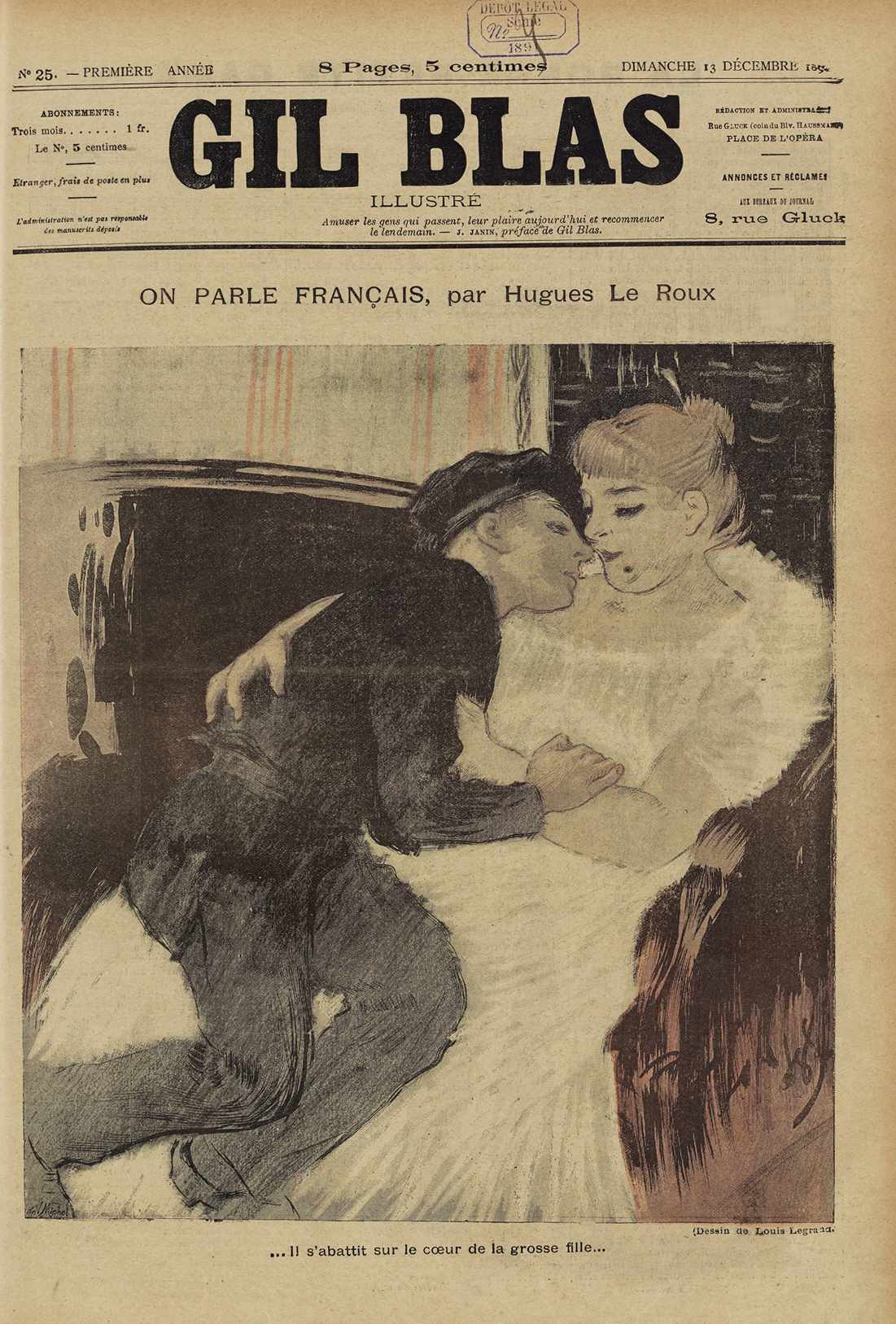
103. Louis Legrand, Angèle and the Cabin Boy
| Artist | Louis Legrand, French, Dijon 1863–Livry-Gargan, Seine-Saint-Denis 1951 |
| Title, Date | Angèle and the Cabin Boy, c. 1890 |
| Medium | Pen and ink, brush and wash, and white gouache |
| Dimensions | 10 1/4 × 9 1/2 in. (26 × 24.1 cm) |
| Inscriptions + Marks | Lower right: L.G 91 [?] [partially illegible] |
| Provenance | [Marcel Lecomte, Paris, until 1970s; to Weisberg]; Yvonne and Gabriel Weisberg, Minneapolis |
| References | "Gil Blas Illustré," vol. 1, no. 25 (Sunday supplement, December 13, 1891), cover |
| Credit Line | Promised gift of Gabriel P. and Yvonne M.L. Weisberg, Minneapolis |
In December 1891, the French literary journal Gil Blas Illustré put this unusual drawing by Louis Legrand on the cover of its Sunday supplement (fig. 1).1 It appeared in a colorized version to illustrate a tender and humorous short story by Hugues Le Roux, “On parle français,” which appeared on the inside pages.2

The story involves a fifteen-year-old French cabin boy whose ship has docked for repairs in Australia. Finding himself amid the filth and hubbub of the port, he decides to wander the quiet streets instead of drinking in a tavern. Upon seeing a sign reading “On parle français” (We speak French), he innocently enters a brothel. The madam hears that he speaks French and calls for Angèle, who is French. Angèle is amused to find that the boy prefers to chat rather than partake of her usual offerings. She learns that his mother has died and that he has had difficulty with his stepmother. Angèle wants to take most of the boy’s money, two gold pieces, but fights back her greed and returns one coin. He buries his face in her bosom and cries. As he does so, Angèle’s memories of her childhood home, a thatched cottage in the French countryside, well up, and she holds him closely. Eventually, he must go. Angèle hopes to see him again, but his ship departs the next day. As the boy leaves, she asks him for change to buy cigarettes so that she can smoke while she thinks of him.
Legrand’s illustration appeared above the caption, “. . . Il s’abattit sur la coeur de la grosse fille . . .” (He fell on the breast of the fat girl). Legrand is noted for pushing the boundaries of propriety in his art, but here he restrained himself. He could have played up the comic possibilities of the slight teenage boy pressing his face into Angèle’s chest, as described by Le Roux. Instead, he concentrated on the tenderness of the brief encounter between two lost souls who found themselves at the far end of the world.
TER
Notes
Gil Blas was published regularly from 1879 until it was disrupted by war in 1914. Afterward, it appeared sporadically. The name of the publication was taken from Alain-René Lesage’s picaresque novel, published in 1715–35. Legrand was a frequent contributor of magazine illustrations. The Jaquet Collection at the Biblothèque nationale has two scrapbooks containing cuttings of his illustrations: https://gallica.bnf.fr/ark:/12148/btv1b530788882/f3.item.zoom ↩︎
Hugues Le Roux is the pen name of Robert Charles Henri Le Roux (1860–1925), a French author and journalist who wrote primarily about the French colonies and travels. “On parle français” was published under the title “Chez les filles” in a book of Le Roux short stories, Chez les filles (Paris: Victor Havard, 1888), pp. 1–12. ↩︎